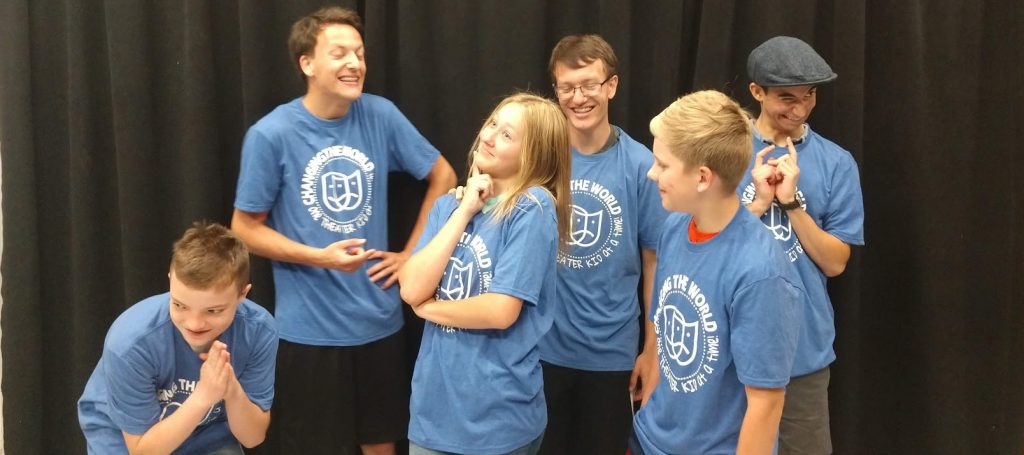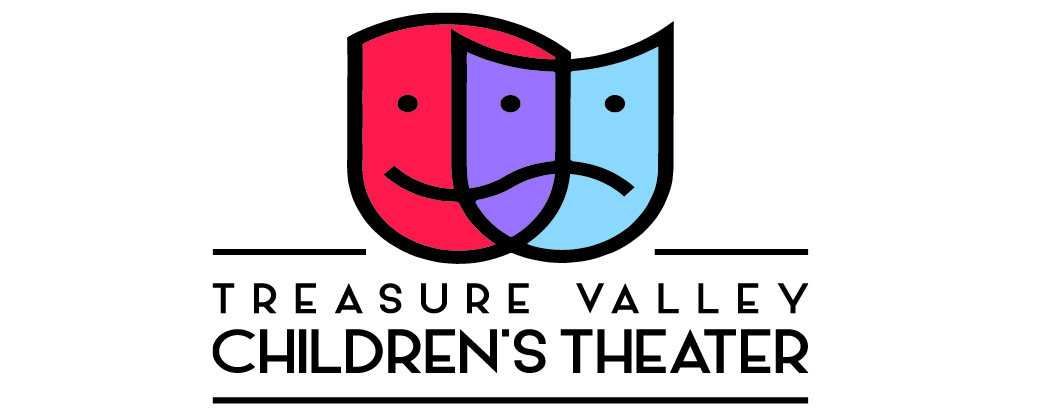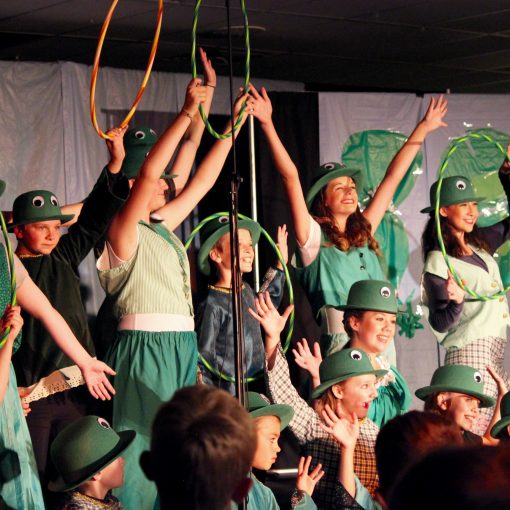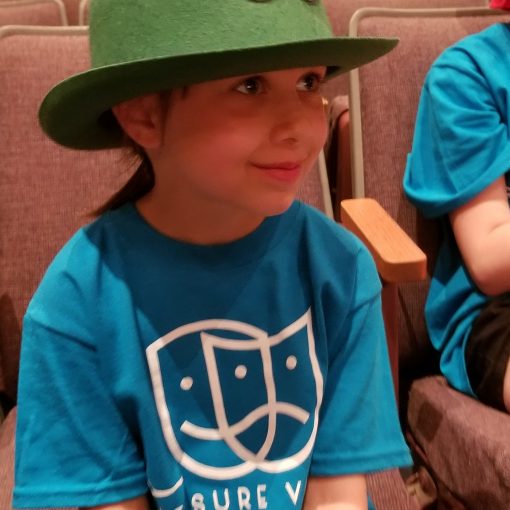The winter blues… a phenomenon that, unfortunately, many of us can relate to. It seems so much easier to enjoy quality time as a family when the sun is on your side, right? Family bike rides, river floats, pickleball matches, hikes, picnics…. birds chirping… sun shining… ahhhh…. *cue harsh realization that it’s only February and we still have months of cold, gray, indoor weather to SOMEHOW get through.* Well, don’t worry! We have something that can help.
Theatre kids are a specific type of breed, and so are the games they— I mean, we— like to play. Theatre games help develop skills like communication, team building, focus, listening, and improvisation. But what are they more commonly known for? Being FUN! I mean seriously, have you ever played a theatre game you didn’t like? (don’t answer that, introverts).
We would like to share with you five theatre games that you can play at home as a family. So unplug those video games, put those cell phones on airplane mode, and get in a big circle, a circle that’s big, a cig bircle, a bircle that’s cig (if you know, you know).

1. Whoop!
This improv game is basically like a giant game of telephone— acting version. One person will be the “starter,” while everyone else will go into another room. The starter will decide on three things: a place, an occupation, and an object (use the acronym POO to help you remember). The starter’s job is to welcome one person from the other room into the space, and act out the POO, one by one. When the person thinks they know what place is being acted out, they will say “whoop!” and then the starter will move on to the occupation. When the person says “whoop!” again, the starter will move on to the object. The person will not disclose what they thought the POO was, but instead, act those three things out to the next person, who repeats the same process. This continues with each person, and then at the end, everyone reveals what they thought the POO was. Here’s the trick: NO TALKING! Making sounds and speaking gibberish is totally encouraged, but actual words are not allowed.
*** Tip: Rather than just acting these things out like a game of charades, try to form a scene surrounding these three things that includes the other person. For example, if the place is Disneyland, pretend like you and the person are at Disneyland together! Maybe you ride a rollercoaster together, buy some churros, greet a character, etc. And encourage the person to participate with you. This is a whole lot more fun than acting something out while the other person stands and stares at you with a confused expression.
2. Zip Zap Zop
This game is a theater kid CLASSIC! The ultimate focus game. Everyone stands in a circle facing each other. One person will start by saying “zip” and pointing to another person in the circle. That person then says “zap” and points to someone else, who then says “zop” and points to someone else. The order of who gets pointed to is completely random. The goal is to keep going for as long as possible without messing up. When you’re ready, you can add in other trios of words to mix things up, like a-b-c, one-two-three, do-re-mi, or rock-paper-scissors. Just make sure the trios of words stay in their trios— so no “zip-two-mi.”
*** Tip: It’s fun to play with eliminations! When someone messes up, they are out. Try having the people who get eliminated become “distractors.” Their job is to move around the outside of the circle (no talking, of course) and attempt to distract the remaining players!
3. Why Are You Late?
This improv game is always a crowd favorite in our TVCT classes. And it’s a good one if you have littles in your family. This game requires at least three people. One person is late to work, one person is the boss, and the other person (can be two or three people), are the other employees. The late person will go into another room while everyone else will decide on three reasons that the person is late to work. The first one should be simple (for example, they woke up late). The second one should be more complex (for example, they couldn’t find their toothbrush), and the third one should be even more complex (for example, they got attacked by a kangaroo). When the late person comes into the room, the boss will ask them “why are you late?” The other employees then have to act out each reason one at a time behind the boss, so that the late person can try to guess. When they say the correct reason, the employees move on to the next one, until all three reasons have been guessed. If there are spectators watching, they become the “snappers and clappers.” When the late person guesses the right answer, they should clap. If the late person is close to the right answer, they should clap to let them know that they are on the right track.
*** Tip: The “boss” is the key to this game flowing smoothly. They should improvise with funny comments and conversation while the acting is taking place. They might even turn around at some point and question whether or not the employees are doing their job, causing the employees to scramble and come up with an explanation for jumping around like a kangaroo while on the clock. The boss can also help the late person get to the correct answer if they need some extra help, with questions like “hmmm, are you sure it was a rabbit that attacked you, or was it a different jumping animal?” We recommend having an adult play this role or an older experienced theater kid.
4. Find the Leader
This is another circle-starting game (see why we have that fun little chant?). One person goes into another room, while everyone else decides on a leader. The leader’s job is to start doing an action (examples: snapping their fingers, patting their legs, rolling their arms, touching their heads, etc.) The action must change frequently. Everyone else’s job is to simply follow the leader and do what they do. The person from the other room stands in the middle of the circle while this is going on and tries to determine who the leader is. Everyone should work as a team to make it really hard to tell who the leader is.
*** Tip: Play a fun song in the background that everyone likes! This makes the actions become more like dance moves. Plus, fun music is the ultimate mood booster!
5. Party Quirks
Another improv classic! This game requires one “party host” and any number of “party guests.” The party host leaves the room while everyone else comes up with a party quirk for each guest. Their quirk can be anything, literally ANYTHING! Maybe they are a specific character (like Elsa or SpongeBob). Maybe they are a type of person (like a TikTok dancer or a dentist). Maybe they are in a certain situation or they have a specific personality trait (examples: afraid of parties, jetlagged, thinks they are invisible, the party host’s therapist, etc.) You can even get crazy and assign someone to an object, like a pencil or an alarm clock. One by one, the party guests enter the party. The party host’s job is to interact with each guest, as well as watch them interact with each other, in order to guess each guest’s quirk.
*** Tip: Decide on a party theme! Birthday party, taco party, craft party, you name it. This will give you more to work with and it just makes it more fun!
Well, there you have it! No more slouching around or absurd amounts of screen time this winter. Let us know your favorite game by emailing us or message us on Facebook or Instagram, we would love to hear from you!



